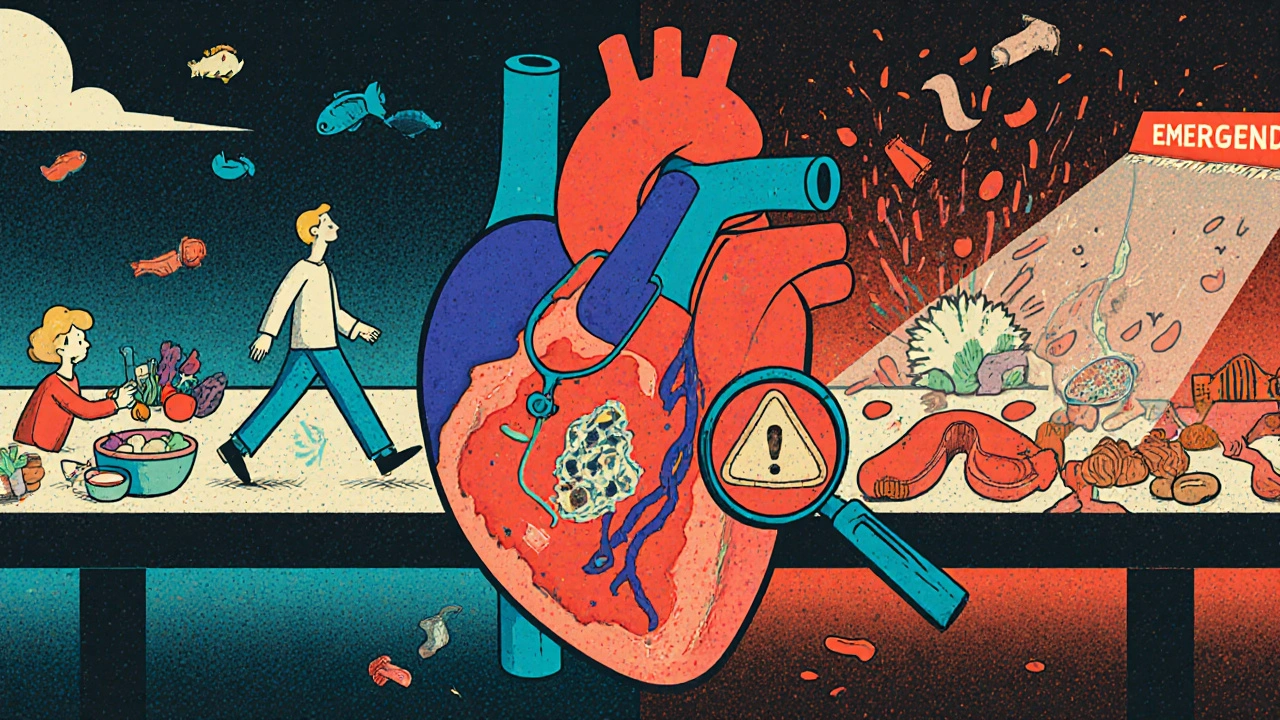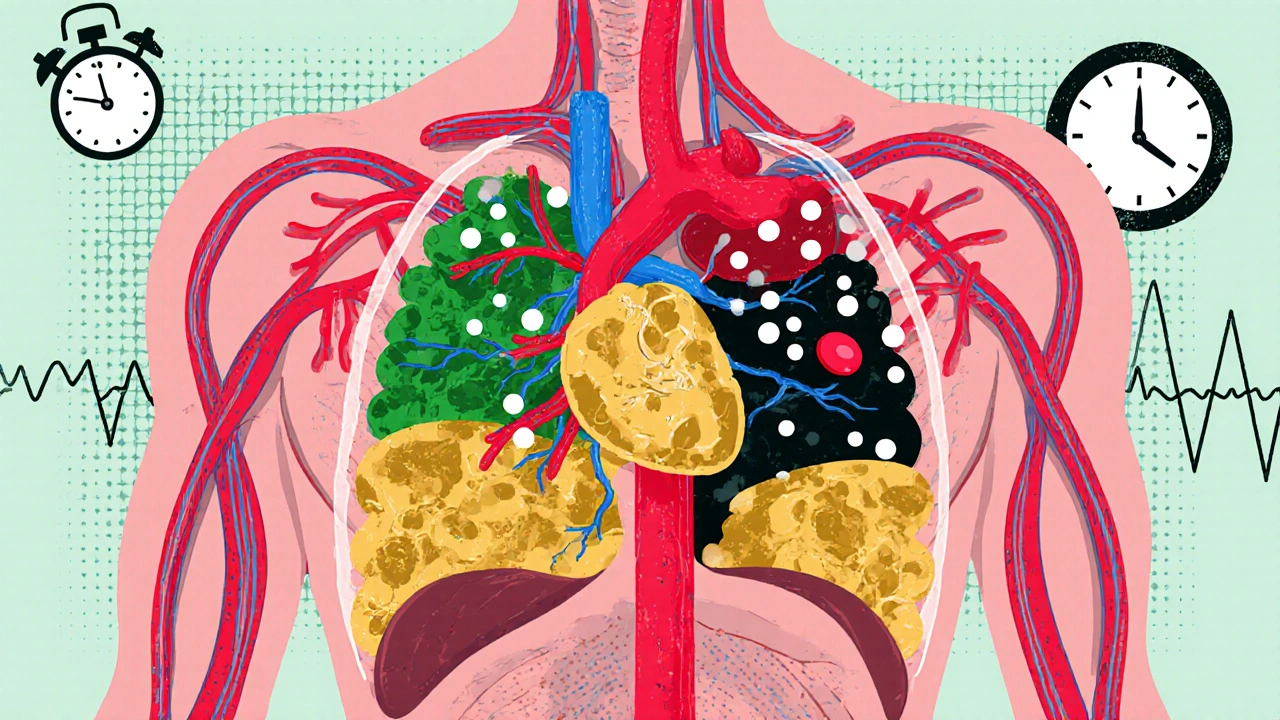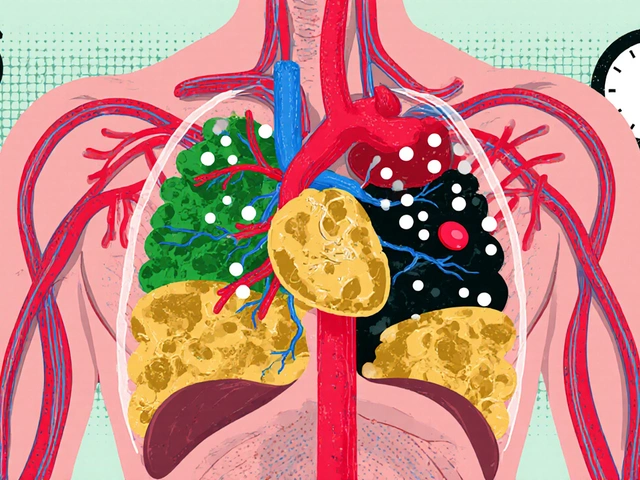Coronary artery disease (CAD) isn't just a slow clog in the pipes-it’s a silent, ticking time bomb in your chest. Every year, over 360,000 people in the U.S. alone die from it. Globally, it’s responsible for 13% of all deaths. And here’s the thing: most people don’t realize they have it until something serious happens. That’s because CAD starts quietly, with fatty deposits building up over decades, often without symptoms. By the time chest pain shows up, the damage may already be advanced.
What Is Atherosclerosis, Really?
Atherosclerosis is the root cause of coronary artery disease. It’s not just cholesterol clogging your arteries-it’s a complex, active process inside the artery walls. Low-density lipoprotein (LDL), often called "bad cholesterol," slips into the lining of your arteries. Your immune system sends in white blood cells to clean it up. But instead of cleaning, they turn into foam cells, triggering inflammation. Over time, smooth muscle cells and fibrous tissue build up around this mess, forming a plaque.
Not all plaques are the same. Some are stable-thick, fibrous caps over a smaller lipid core. These can narrow the artery by more than 50%, causing predictable chest pain during exercise. Others are unstable: thin caps, big fatty cores, packed with inflammatory cells. These don’t always narrow the artery much-sometimes less than 50%-but they’re dangerous because they can rupture without warning. When they do, a blood clot forms on the spot, blocking blood flow completely. That’s when a heart attack happens.
This is why two people with the same level of artery narrowing can have totally different outcomes. One might have stable angina and live for years. The other could have a sudden cardiac event from a plaque that looked harmless on a scan.
Who’s at Risk? The Real Culprits Behind CAD
It’s easy to blame genetics or bad luck, but the biggest risk factors for CAD are mostly within your control. The 2023 ACC/AHA guidelines break risk into three levels: low (<1% chance of heart attack or death per year), intermediate (1-3%), and high (>3%). Most people who have heart attacks fall into the high-risk group.
Here’s who’s most at risk:
- Smokers: Smoking damages the artery lining, speeds up plaque buildup, and makes blood more likely to clot. Even occasional smoking raises your risk.
- People with diabetes: High blood sugar eats away at blood vessels. Diabetics are two to four times more likely to develop CAD than non-diabetics.
- Those with high LDL cholesterol: Levels above 160 mg/dL significantly increase risk. But even levels between 130-159 mg/dL can be dangerous if other risks are present.
- People with high blood pressure: Consistently above 130/80 mmHg puts extra strain on arteries, making them more prone to damage.
- Individuals with obesity: Especially with belly fat (waist over 40 inches for men, 35 for women). Fat tissue releases inflammatory chemicals that worsen atherosclerosis.
- Those with a history of heart attack, bypass surgery, or stents: Once you’ve had one event, your risk of another skyrockets.
- People with chronic kidney disease: An eGFR below 60 ml/min is a red flag. Kidney function and heart health are deeply linked.
Here’s something surprising: nearly 75% of first heart attacks happen in people classified as high-risk. Yet, many of these people aren’t even on the right medications. Risk isn’t just about numbers-it’s about patterns. If you have two or more of these risk factors, your chances of a major event jump dramatically.
How Is CAD Diagnosed? Beyond the Chest Pain
Many people assume chest pain is the only sign of CAD. But it’s not that simple. Some have no pain at all-especially women, older adults, and diabetics. Instead, they might feel tired, short of breath, or have nausea during activity. That’s why diagnosis isn’t just about symptoms.
Doctors use a mix of tools:
- Electrocardiogram (ECG): This quick, painless test checks your heart’s electrical activity. It can spot signs of past heart damage or current strain.
- Stress tests: You walk on a treadmill or ride a stationary bike while your heart is monitored. If your heart doesn’t get enough blood during exertion, it shows up as abnormal patterns.
- Coronary angiography: The gold standard. A thin tube is threaded into your artery, dye is injected, and X-rays show exactly where blockages are. It’s invasive, but often necessary before treatment.
- Ankle-Brachial Index (ABI): This simple test compares blood pressure in your ankle to your arm. If it’s low, it means you likely have plaque in your leg arteries too-which almost always means you have it in your heart arteries as well.
Recent guidelines also recognize "ischemia with nonobstructive coronary arteries" (INOCA). This means you have heart symptoms and reduced blood flow, but no major blockages on angiography. It’s real, it’s common, and it’s often overlooked. In these cases, tiny vessel disease or endothelial dysfunction is the culprit.
Treatment: It’s Not Just Pills and Surgery
There’s no magic bullet. Effective CAD treatment combines lifestyle changes, medications, and sometimes procedures-all tailored to your risk level.
Lifestyle is the foundation. No pill works as well as quitting smoking, eating real food, and moving daily. The Mediterranean diet-rich in olive oil, fish, nuts, vegetables, and whole grains-has been shown to reduce heart events by up to 30%. Walking 30 minutes a day, five days a week, cuts your risk of dying from CAD by nearly half.
Medications are non-negotiable for most. Here’s what’s typically prescribed:
- Statins: Lower LDL cholesterol and stabilize plaques. Even if your LDL is "normal," statins are often still recommended for high-risk patients.
- Aspirin: Used for secondary prevention (after a heart attack or stent). Not routinely recommended for primary prevention unless you’re very high risk.
- ACE inhibitors or ARBs: Help lower blood pressure and reduce heart strain, especially if you have diabetes or heart failure.
- Beta-blockers: Slow your heart rate, lower blood pressure, and reduce oxygen demand on the heart. Often used after a heart attack.
- SGLT2 inhibitors and GLP-1 agonists: Originally for diabetes, these drugs now show strong heart protection-even in people without diabetes.
Procedures: When and Why
- Percutaneous Coronary Intervention (PCI): A balloon is inflated to open a blocked artery, then a stent is placed to keep it open. Best for sudden blockages or severe angina. Not always needed for stable disease.
- Coronary Artery Bypass Grafting (CABG): A surgeon takes a blood vessel from your leg or chest and reroutes blood around the blockage. Recommended for multi-vessel disease, especially if you have diabetes.
Here’s the key: PCI doesn’t extend life in stable CAD. It only helps with symptoms. CABG, however, can improve survival in complex cases. The decision isn’t about what’s available-it’s about what’s right for your risk profile.
The New Frontier: Cardio-Oncology and Personalized Care
As more people survive cancer, we’re seeing more overlap. Chemotherapy and radiation can damage the heart. At the same time, heart disease patients are living longer with chronic conditions. That’s why cardio-oncology is growing fast-a field focused on managing both heart disease and cancer together.
Also, treatment is becoming more personalized. The 2023 guidelines stress that risk assessment isn’t just a number. It’s about your age, gender, family history, kidney function, inflammation markers, and even your mental health. Stress and depression are now recognized as independent risk factors for heart events.
Future treatments are looking at ways to stabilize plaques before they rupture-using drugs that target inflammation, not just cholesterol. Trials are underway for therapies that reduce plaque volume or change its composition. For now, the best tool we have is early detection and consistent management.

What You Can Do Today
If you’re worried about CAD, don’t wait for symptoms. Start with these steps:
- Get your blood pressure, cholesterol, and blood sugar checked-especially if you’re over 40 or have a family history.
- If you smoke, quit. Even one cigarette a day raises your risk. Support programs and nicotine replacement work.
- Move more. You don’t need to run a marathon. Aim for 150 minutes of brisk walking a week.
- Eat more plants. Swap processed snacks for nuts, fruit, or veggies. Cook with olive oil instead of butter.
- Ask your doctor about your risk score. Don’t just accept "you’re fine"-ask: "Am I low, medium, or high risk? What should I be doing differently?"
Coronary artery disease isn’t a death sentence. It’s a chronic condition-and like diabetes or high blood pressure-it can be managed. The difference between living well and facing a heart attack often comes down to one thing: acting before it’s too late.
Can you reverse coronary artery disease?
You can’t completely erase plaque, but you can stabilize it and even reduce its size. Aggressive lifestyle changes-like the Ornish or Mediterranean diets combined with daily exercise and stress management-have been shown to shrink plaque in studies. Statins also help by lowering LDL and reducing inflammation. The goal isn’t to make arteries perfectly clean-it’s to prevent rupture and blockage.
Do I need a stent if I have chest pain?
Not always. If your chest pain happens only with exertion and goes away with rest, you likely have stable angina. In that case, medications and lifestyle changes are the first-line treatment. Stents are usually reserved for when symptoms don’t improve with meds, or if tests show a severe blockage threatening heart muscle. For stable CAD, stents don’t extend life-they just relieve symptoms.
Can young people get coronary artery disease?
Yes. While CAD is more common after 50, plaque starts building in your 20s and 30s. With rising obesity, diabetes, and smoking rates in younger adults, heart attacks are now happening in people as young as 30. Genetics can play a role, but lifestyle is the biggest driver. If you have a family history and unhealthy habits, you’re at risk-even if you feel fine.
Is heart disease hereditary?
Having a close relative who had heart disease before age 55 (for men) or 65 (for women) increases your risk. But genes don’t determine your fate. Even with a strong family history, you can lower your risk significantly by controlling blood pressure, cholesterol, weight, and avoiding smoking. Genetics loads the gun-lifestyle pulls the trigger.
What’s the difference between stable and unstable angina?
Stable angina happens predictably-during exercise or stress-and goes away with rest or nitroglycerin. It’s caused by a fixed, narrow blockage. Unstable angina comes on suddenly, even at rest, lasts longer, and doesn’t fully resolve with rest or medication. It signals a ruptured or nearly blocked plaque and is a medical emergency. If you experience this, call for help immediately.
What Comes Next?
If you’ve been diagnosed with CAD, your next step isn’t panic-it’s planning. Work with your doctor to understand your risk level. Get a full lipid panel, check your kidney function, and ask about inflammation markers like hs-CRP. Don’t skip follow-ups. Many people start meds, feel better, and stop taking them. That’s when things go wrong.
If you haven’t been diagnosed but have risk factors, don’t wait for symptoms. Talk to your doctor about screening. A simple ABI test or stress test might be all you need to catch early disease. Prevention isn’t optional-it’s the most powerful treatment we have.


